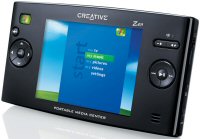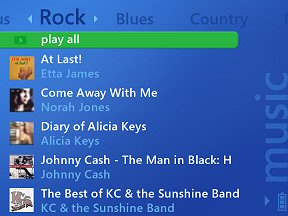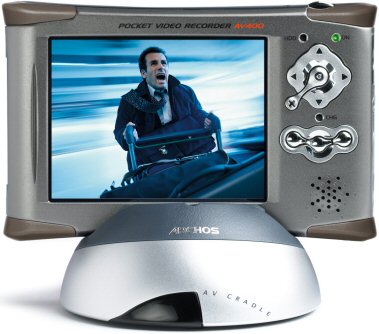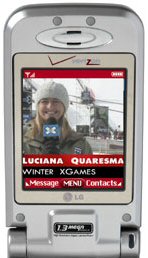Manifest Technology Blog
-- Site:
| Articles
| Galleries
| Resources
| DVI Tech
| About
| Site Map
|
Articles:
| PC Video
| Web Media
| DVD & CD
| Portable Media
| Digital Imaging
| Wireless Media
| Home Media
| Tech & Society
|
Portable Media:
| Portable Media Articles
| Portable Media Player Gallery
|
Portable Media Devices (4/2005)
(Creative Zen Portable Media Player
Archos Pocket Video Recorder,
Samsung SCH-a890, Verizon V CAST)
by Douglas Dixon
Beginnings: Portable Music Players
Adding Video: Creative Zen Portable Media Player
Recording Video: Archos Pocket Video Recorder
Video Capture on Mobile Phones: Samsung SCH-a890
Video on Mobile Phones: Verizon V CAST
Portable Video
References
See Media to Go: Microsoft Windows Media Player 10
The explosion of consumer interest in handheld devices has fueled an ongoing
battle in the consumer electronics industry -- not so much between different
companies, products, or technologies -- but more fundamentally to understand and
satisfy consumer desires: finding the right combinations of features to be
integrated into convenient portable form factors that win with consumers. For
example, over the past few years we have seen this kind of battle play out in
the convergence of mobile phones and PDAs, now apparently settling on PDA/phones
in the style of the PalmOne Treo.
Similarly, the portable music player market seems to have settled into
several tiers, from "lipstick" sold state players to "mini"
and larger players based on hard disks. But the convergence thing is still going
strong: as technology improvements allow audio players to add more storage and
larger displays, the drive to integrate additional functionality becomes
unstoppable -- as the pure Apple iPod audio player includes games and organizer
functions, and then expands to the iPod Photo, and other players add additional
features such as FM radio and voice recording.
Meanwhile, a different class of device has been invading the same territory.
As mobile phones have added digital cameras and expandable memory, they too have
become portable music players and digital photo albums. The tremendous adoption
rates and continued upgrades of mobile phones will soon cause the number of
these devices to overwhelm stand-alone digital cameras and audio players. The
dedicated devices will need to compete on quality (i.e., better camera lens) and
usability (i.e., more convenient than a tiny numeric touchpad).
This year's new skirmish comes from the addition of motion video to these
devices, as portable media players and mobile phones offer two very different
models for storing and accessing video content. Portable media players from
companies like Creative and Archos have an obvious advantage for video playback
in that they have larger displays and more storage (with hard disk drives),
which works well for downloaded content, especially full-length movies. But
mobile phone video services like Verizon V CAST now can provide on-demand access
to fresh broadcast content like news and sports, albeit short form clips and
displayed on a smaller screen.
As a starting point, consider how the market for portable music players has
consolidated into three general categories: tiny "lipstick" players
based on sold state cards holding up to about 1 GB, weighing under an ounce and
priced under $100 (recently joined by the iPod Shuffle); pocket-size
players adding a small hard drive for up to around 6 GB, but still weighing
under 4 ounces and priced up to around $250 (like the iPod Mini); and
slightly larger players with larger drives up to 40 GB and beyond, weighing
under 6 ounces and priced a tad higher at $200 - $400 (www.apple.com/ipod).
The designers of these devices are caught in a constant trade-off between
capacity and portability. In particular, the displays of the smaller units have
been reduced to simple grayscale text, still good enough to display menus and
song titles. But displaying photos and video requires bulking up for a better
display. To add photos to the iPod, Apple added a 2 inch diagonal, 220 x 176 LCD
display with 65K colors, and updated the iPod Photo up to 60 GB for $450,
increasing the weight from 5.6 to 6.4 ounces, and the thickness from 0.57 to
0.75 inches.
Even after bulking up a portable player to display photos, the step to video
still requires more processing power on the device, as well as a more
sophisticated interface between the device and the computer to manage video
content. The iPod is managed with Apple's iTunes digital jukebox software, which
then needed to be extended for the iPod Photo to support synchronizing images as
well.
Meanwhile, Microsoft's solution is to use Windows Media Player to synch all
forms of digital media with portable devices, including music, photos, and
video. Windows Media Player 10, released in September 2004, supports
synchronizing the media library with over 70 supported portable devices
(identified with Microsoft's new PlaysForSure logo program, www.playsforsure.com).
Media Player 10 also enhances purchasing protected content from online stores,
using Windows Media Digital Rights Management (DRM), and maintaining the DRM
protection into supported portable devices.
To move beyond audio, Microsoft established the Portable Media Center (PMC)
as a new class of portable device that integrates directly with Windows Media
Player -- just select clips or playlists under your media Library, and click
Sync to transfer them to the device, converting formats as needed. The interface
for PMC devices is familiar from Media Center PCs, with simple menus designed
for simple controls (i.e., accessed across the room with a remote control
instead of a mouse and keyboard). But since the focus for PMC devices is video
playback, it makes sense to increase the screen size (and resolution) and bulk
up the player a bit to provide more accessible controls.
The result is a device like the Creative Zen Portable Media Center,
with a 3.8 inch LCD TFD display at 320 x 240 resolution, and including analog
audio and video outputs for display on televisions (NTSC or PAL). The Zen PMC is
priced around $499 with a 20 GB hard drive, and is no longer quite pocket sized
at 5.67 x 3.18 x 1.06 inches and 12 ounces (www.creative.com).
 Creative Zen Portable Media Center
Creative Zen Portable Media Center
With the Zen PMC you can store some 9,000 songs or 85 hours of movies in
Widows Media 9 Audio and Video formats, including downloaded clips and movies,
broadcast shows recorded on a Media Center PC, as well as your own videos that
you have captured and edited. While handheld, the device is large enough that
you can comfortably watch longer videos, and even share the experience with
another person or two.
 Creative Zen: Rock albums
Creative Zen: Rock albums
Even better, you can make your media portable without even requiring a
computer as an intermediary. The Archos AV400 pocket video recorder line
serves as both a playback device and a self-contained media recorder (www.archos.com).
It also supports a wider variety of formats, and is less tightly integrated with
Windows Media Player. It plays audio in MP3, WMA (with DRM), and WAV formats,
and supports voice recording with a built-in microphone and stereo music
recording with an optional FM Tuner. It displays images in standard JPEG and BMP
formats, and includes a CompactFlash reader to transfer photos from a digital
camera. And for video, it supports MPEG-4 video playback in Windows AVI (and
DivX) format, and can directly record video and TV through a docking cradle,
including scheduled recordings.
 Archos AV400
Archos AV400
The AV400 display is a 3.5 inch TFT LCD at 320 x 240 resolution. The product
line started with 20 and 80 GB capacities and then took a big jump to 100 GB in
early 2005: the AV420 ($499.95), AV480 ($749.95), and AV4100 ($799.95). The
units are relatively small at 4.9 x 3.1 x 0.8 inches (1.0 thick for higher
capacities), and only 9.88 (11.29) ounces.
The AV400 supports older Windows (98 and later) and Mac (9.2 and later)
machines, and on Windows XP it supports Windows Media Player 10, including
Windows Media DRM for audio, with video DRM support promised before mid-year. In
addition, like the Zen PMC and other Windows-based devices, when you connect to
your PC (over USB), the device is mounted on the desktop as a removable drive,
so you can use it as a convenient portable disk drive, and therefore manually
copy media files directly to and from the storage.
While these portable devices are great for packing mass quantities of media,
and especially for long-form albums and movies, they are yet another device (and
associated power supply) to pack and carry. Meanwhile your mobile phone is
always with you, but has been restricted as a portable player by the smaller
display and limited built-in storage (i.e., measured in MBs and not GBs). But as
cameras become more ubiquitous in mobile phones, all the capability is in place
to have your phone become a media playback and recording device for audio,
images, and video.
The mobile carriers have been growing the business of providing on-demand
access to media: downloading ring tones and then music, screen savers and then
photos. This revenue opportunity then was further expanded by camera phones,
with the need for uploading services to send photos to friends and transfer to
a computer. The next obvious step as mobile phones become general media
storage and playback devices was to add memory cards to expand the storage
capacity.
Interestingly, this has lead to a serious conflict with customer
expectations: consumers are used to connecting to their computer to
synchronize media files, while the mobile business is based on monetizing all
transfer of content to and from the phone. As a result, mobile phones do not
have USB ports, and while more phones are adding Bluetooth communications for
use with wireless headsets, the carriers are not supporting it for general
file transfer to a computer. For the moment, loading your mobile phone as a
music jukebox or photo album is best done through the storage card.
Camera phones now do video as well, at least recording and playback of short
clips. For example, the Samsung SCH-a890 from Verizon Wireless
($249.99 after $70 rebate) is definitely portable -- this flip unit is
comparable to the iPod mini at 3.5 x 2.0 x 1.0 inches, and 2.8 ounces (www.samsungusa.com/wireless).
It's around the same size, thicker, but also lighter -- plus the display is in
color, at 176 x 220 and 262K colors (plus a smaller display on the outer case).
Besides the phone features, it includes organizer functions and voice
activation, plus multimedia messaging, downloadable applications and games
through Verizon's Get It Now service, and Mobile Web access (www.verizonwireless.com).
 Samsung SCH-a890
Samsung SCH-a890
For photos, the rotating 1.3 megapixel camera shoots at up to 1280 x 960
resolution, and captures short MPEG-4 video clips (up to 15 seconds) at 176 x
122 resolution and 15 frames per second. Your photos, videos, and audio clips
can be saved on the phone in the Media Gallery, shared with friends through
multimedia messaging, transferred via e-mail, or uploaded to the Verizon Pix
Place Web portal (www.vzwpix.com).
The trade-off for all this capability in a tiny handheld device, however, is
the limited built-in memory compared to 4 to 6 GB on small audio players: the
memory is apparently sub-divided into chunks including 8 MB for photo and video
capture, 14 MB for the media gallery, and 54 MB for downloaded applications..
And there's no built-in memory card slot on this model.
Yes, today's mobile phones can be portable media players, but only for
relatively short clips (and with the small screen really viewable only by one
person at a time). But there's one more option with mobile phones that breaks
the local storage limitations -- using the wireless access to view streamed
content. This is the premise of the Verizon Wireless V CAST
third-generation (3G) wireless consumer multimedia service, introduced in
February 2005 ( www.verizonwireless.com/getitnow/videoclips).
V CAST is built on the Verizon broadband EV-DO (Evolution-Data Optimized)
3G network, with transmission speeds capable of bursts up to 2.4 megabits
per second (Mbps), and average download speeds of 300 to 500 Kbps. Verizon
reports that by the end of 2004 the EV-DO network had been deployed in areas
covering 75 million people, or one-third of its network in the United States,
and is targeting 150 million by the end of 2005.
For an additional monthly access fee of $15, the V CAST service provides
unlimited access to more than 300 videos from leading content providers,
including News from CNN and NBC; Entertainment from E!, Comedy Central, VH1, and
Sesame Street; Sports from ESPN, Fox, Nascar, and NBA; and Weather from
AccuWeather. The service also includes new "3D" games, unlimited
airtime for Get It Now downloadable applications and games, and Mobile Web
service.
  V CAST - NBC Mobile and ESPN 2
V CAST - NBC Mobile and ESPN 2
V CAST uses the PacketVideo player on supported phones including the Samsung
SCH-a890 and LG VX8000. The clips play at 176 x 132 resolution at 15 frames per
second using Windows Media 9 format. Most clips around 2 to 3 minutes in length,
and take 10 to 30 seconds to buffer up before playing.
However, these clips are not live: the news and weather clips can be updated
several times a day, and the sports and entertainment clips are updated daily to
weekly. Verizon is also releasing several original series as "mobisodes"
-- original one-minute mobile episodes including "24: Conspiracy" from
Twentieth Century Fox Television, and two productions from Twentieth Television:
"Sunset Hotel," a soap opera, and "Love and Hate," described
as a "quasi-reality series."
The consumer electronics revolutions continue: digital photography is
ubiquitous, portable audio players have exploded into the mainstream, and
cameras are converging onto mobile phones. But the battle for consumer favor
continues, as the market has not yet established the right balance of form
factor and functionality for how all these devices will integrate.
Mobile phones can certainly be a personal audio player, photo album, and even
video and TV display, but are restricted by the small form factor: the clips are
relatively short, memory expansion is limited to storage cards and not hard
disks, and the viewing experience is compromised by smaller displays and limited
A/V connectivity.
Meanwhile, portable audio players are bulking up to add photos and then
become portable media centers with video playback. With larger screens, they are
worth packing to provide a more comfortable travel and group viewing experience.
And with hard disk capacities growing from 10 / 20 GB to 80 / 100 GB, you do not
need to decide which portion of your music library to bring on a storage card --
you can just bring it all on hard disk.
You'll never have to be without your favorite media again.
PalmOne - Treo
www.palmone.com/us/products/smartphones
Apple - iPod
www.apple.com/ipod
Microsoft - Windows Media Player 10
www.microsoft.com/windows/windowsmedia/mp10
Windows Media Cool Devices
www.microsoft.com/windows/windowsmedia/devices
PlaysForSure
www.playsforsure.com
Creative Zen Portable Media Center
www.creative.com
Archos
www.archos.com
Verizon Wireless
www.verizonwireless.com
Verizon - V CAST
www.verizonwireless.com/getitnow/videoclips
Verizon Pix Place
www.vzwpix.com
Samsung Telecommunications
www.samsungusa.com/wireless
|
